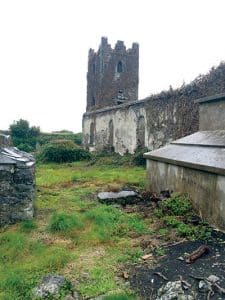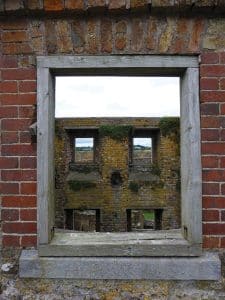On 8 February 2017 the inaugural meeting of SPAB Ireland (The Society for the Protection of Ancient Buildings in Ireland) took place. In the audience were the bulwarks of Irish architectural heritage; the Irish Georgian Society, the Irish Landmark Trust, An Taisce, the Dublin Civic Trust. But the demographic for SPAB were better than for any of these organisations. The first meeting in Trinity was overflowing. Its convenors are graduates who have recently completed SPAB Scholarships in the UK, with the aim of extending SPAB to Ireland. The first meeting in Trinity was overflowing.
SPAB is a charity founded in 1877 by William Morris. Though best known in his lifetime as a poet and social campaigner, he posthumously became better known for his designs, particularly of textiles. It was founded in response to the highly destructive, if well-intentioned, ‘restoration’ of medieval buildings popular with many Victorian architects, exemplified in Ireland by the overdone Dublin Cathedrals. Today SPAB claims to be the largest, oldest and most technically expert national pressure group fighting to save old buildings from decay, demolition and damage. To this day the 1877 manifesto remains the basis for the Society’s work.

Left to right, Tríona Byrne, Oliver Wilson, Conor Meehan, Eoin Madigan and Rachel Morley
Village spoke to Rachel Morley, Tríona Byrne and Oliver Wilson, SPAB convenors, about the future of SPAB Ireland.
According to Morley, SPAB has a statutory role as adviser to local planning authorities in Britain. “We must be notified of listed building applications that involve total or partial demolition. We are also informed by those religious bodies that have an exemption from the secular system, of certain types of proposal for listed places of worship. In addition, our casework includes campaigning to protect historic buildings at risk”. That sounds like a lot of the work carried out in Ireland by An Taisce though of course An Taisce’s remit is environmental and planning-focused too, and by the Heritage Council on a narrower and professional basis. Morley says that “Ultimately, SPAB Ireland would like to become formal consultees for applications to demolish or partially demolish listed buildings and applications for any works to, say, pre 1720 buildings”.

Morley claims to be a bit of an oddball. While studying Process and Chemical Engineering at UCC, “I fell in love with old buildings – the architecture, the history, the materials, the decay mechanisms and conservation and people’s relationships with old buildings. I went on to study Applied Building Conservation and Repair at TCD. As this course wound up, I desperately wanted to learn more about plaster conservation – learn practical skills. I moved to England and spent twelve months funded by the Heritage Lottery undertaking a training internship in architectural stone and plaster conservation with the Institute of Conservation. I spent several glorious years travelling across England and Europe repairing plasterwork of all periods. I am currently work with the Churches Conservation Trust and am responsible for the repair of 129 redundant Anglican churches across the southeast of England. I am endlessly fascinated and inspired by churches”.
Morley got involved in SPAB in her early twenties while living on the Welsh borders. “It was beautiful, but I was lonely. I wanted to meet like-minded people and I wanted to explore the buildings that surrounded me. SPAB has several regional groups – groups of members who arrange local events, lectures and tours to ensure members throughout the country are engaged with the Society. I joined the local committee and for two years arranged these events. In 2014 I was lucky enough to be elected to the Guardians’ Committee which is responsible for upholding the ethos and traditions of the Society and plays a leading role in the Society’s listed building casework and in historic buildings policy discussions”.

Wilson is an architect, originally from Donegal: “I got the conservation bug quite early, in my late teens I got involved with The Journeymen, a group of craftspeople (led by Séan Brogan) who did craft demonstrations around Donegal, Sligo and Leitrim. I did my ‘part 2’ thesis on Ramelton and after that I worked with Dedalus Architecture (Duncan McLaren), a small but principled conservation practice in Donegal. While there I got a place on the SPAB scholarship in 2015 and since that I’ve been working with Andrew Townsend Architects”.
He’s passionate about conservation and outlines SPAB’s philosophy: “The idea is that a building should be allowed to age gracefully, we love when an old building looks old and see the patina of age as something which should always be retained. Take for instance an old wall that has gone bulged and wobbly and is perhaps on the brink of collapse: rather than take it down and rebuild in the new, the stonework could be stitched together and repaired it in situ, stabilising the wall whilst retaining its wobbliness and telltales of its age”.
Byrne is a structural engineer working in conservation in Dublin. “In 2016, I completed the SPAB scholarship programme, which involved travelling all over the UK for nine months visiting hundreds of building conservation projects and meeting the people involved – craftspeople, contractors, professionals and anyone involved in the project in any way”.

Byrne says that during her scholarship, I kept thinking about how great it would be to have something like the SPAB in Ireland. Whenever I met the other Irish SPAB members, we always spoke about it. I knew I wanted to return to Ireland after my scholarship (as long as I could find a job!), and with Eoin based in Ireland too, we decided it was a good time to try and establish SPAB in Ireland.
Byrne too favours minimal intervention as a philosophy: “SPAB favours a conservationist approach – if there is nothing wrong with a building, why do anything? Often, restoration replaces the history and character of a building, as well as patina of age, with an essentially new building, ‘sanitising’ the old building in the process of restoration”.

As to the future of SPAB and its relations with other worthy bodies, Morley says: “There are many great organisations doing excellent work to protect our built heritage, but we feel there are a few gaps, which we would like to address; as such our three long-term aims are to improve maintenance, undertake casework and work to introduce training in conservation. Maintenance, far from glamorous, is the most fundamental aspect of caring for buildings and perhaps amongst the most quoted line from the Society’s manifesto, “stave off decay with daily care”. Conservation training is all but non-existent in Ireland. “We want to work to improve this situation: to train and upskill contractors, encourage master craftspeople to facilitate training programmes and make young people aware of the opportunities available to conservation craftspeople”.
Morley is practical but cautious about the future for SPAB: “Before we can really get going with these, we need to increase people’s understanding of and appreciation for old buildings. We want people to feel a collective ownership and responsibility for these buildings. We are only the custodians of this glorious legacy. To this end, in the coming twelve to eighteen months we will hold practical demonstrations/workshops, site visits, lectures, tours and so on. We appreciate this is ambitious and we appreciate that to succeed we will need to partner with similar organisations to achieve our mutual goals”.
As to why SPAB has work to do in Ireland, Morley pulls no punches: “Given how vocal heritage bodies in Ireland have been on this issue in recent years and given the government’s low prioritisation of the historic built environment all along, I can only conclude that our public representatives don’t care. It will only take a few hours of driving around the countryside (or towns and villages) in England, Scotland or Wales to notice the difference, how we neglect our built heritage in Ireland is shameful, and it’s very sad”.
Emma Gilleece is a buildings historian working for the RIAI, and a member of An Taisce and the Irish Georgian Society.
spabireland@gmail.com